热门问题
时间线
聊天
视角
傅立葉級數
將周期函數分解為更簡單的正弦形式的和 来自维基百科,自由的百科全书
Remove ads
在數學中,傅立葉級數(英語:Fourier series,/ˈfʊrieɪ, -iər/)是把類似波的函數表示成簡單諧波的方式。更正式地說,對於滿足狄利克雷定理的週期函數,其傅立葉級數是由一組正弦與餘弦函數的加權和表示的方法。傅立葉級數與用來找出無週期函數的頻率資訊的傅立葉轉換有密切的關係。

傅立葉級數是傅立葉分析的一個研究分支,也是取樣定理原始證明的核心。傅立葉級數在數論、組合數學、訊號處理、機率論、統計學、密碼學、聲學、光學等領域都有著廣泛的應用。
歷史
傅立葉級數得名於法國數學家約瑟夫·傅立葉(1768年–1830年),他提出任何函數都可以展開為三角級數。此前數學家歐拉、達朗貝爾和克萊羅,已發現在認定一個函數有三角級數展開後,通過積分方法計算其係數的公式,而拉格朗日等人已經找到了一些非週期函數的三角級數展開。將週期函數分解為簡單振盪函數的總和的最早想法,可以追溯至公元前3世紀古代天文學家的均輪和本輪學說。
傅立葉的工作得到了丹尼爾·伯努利的贊助[1],傅立葉介入三角級數用來解熱傳導方程式,其最初論文雖經西爾維斯特·拉克魯瓦、加斯帕爾·蒙日同意[2],但在1807年經拉格朗日、拉普拉斯和勒讓德評審後被拒絕出版,他的現在被稱為傅里葉逆轉定理的理論後來發表於1822年出版的《熱的解析理論》[3]。
定義

Remove ads
人們常用與的三角級數來表示,就是將所有階諧波與,乘以其各自在中的權重,求得它們的總和;這些階諧波的權重稱爲傅立葉級數係數,它們可以藉由如下積分來獲得:
傅立葉級數係數
符號表示在選定區間上的積分,典型的選擇為或者。注意是函數的平均值[A],這個性質擴展到了類似的轉換比如傅立葉轉換。
通過這些係數定義傅立葉級數為:
傅立葉級數,正弦-餘弦形式
這裡使用符號,表示傅立葉級數的求和不一定總是等於。普遍來說是理論上趨近於無限大的,但是就算趨近於無限大,對所有的(例如在某一點上不連續),傅立葉級數也不一定收斂到 。儘管不收斂的可能性始終存在,在科學和工程領域中經常將Eq. 2中的直接替代為。
在傅立葉級數係數中的整數索引,是級數中相應的或,在這個函數的週期中,形成的圓周(cycle)的數目。因此對應於和的項有著:
Remove ads
根據定義,我們可以得到:
複數傅立葉級數係數
複數傅立葉級數係數
給定複數傅立葉級數係數,可以用公式復原出和:
複數傅立葉級數係數
通過這些定義,傅立葉級數可以寫為:
傅立葉級數,指數形式
Remove ads
人們習慣將的值域普遍化到複數上,設是一個複數值函數,它的實部和虛部,都是實數值函數:
定義則:
對於這個複數值函數,它的傅立葉級數的實部,是它的實部的傅立葉級數;它的傅立葉級數的虛部,是它的虛部的傅立葉級數:
Remove ads
還可以利用三角恆等式,把正弦-餘弦形式中後面的正弦函數跟餘弦函數合併起來:
然後定義振幅,相位,這裡的和對應正弦-餘弦形式中和。是的平均值。
傅立葉級數,振幅-相位形式
Remove ads
在描述傅立葉級數行為的時候,經常會為一個函數介入部份求和算子[5]:
這裡的是的傅立葉係數。不同於微積分中的級數,傅立葉級數的部份求和必須採用對稱形式,否則收斂結果可能不成立。
假設與是在上的可積函數,與在的捲積為:
週期為的函數的傅立葉級數的部份求和,可以經由與狄利克雷核的摺積來表示:
Remove ads
在近似了,該近似程度會隨著逐漸改善。這個無窮和叫做 的傅立葉級數表示。傅立葉級數的收斂性取決於函數有限數量的極大值和極小值,這就是通常稱為傅立葉級數的狄利克雷條件。參見傅立葉級數的收斂性之一。對於廣義函數或分布也可以用範數或弱收斂定義傅立葉係數。在的不可導點上,如果我們只取無窮級數中的有限項求和,那麼在這些點上會有幅度不隨增大而持續變小的起伏,這叫做吉布斯現象,一個簡單的例子是方波訊號。
在工程應用中,一般假定傅立葉級數除了在不連續點以外處處收斂,原因是工程上遇到的函數比數學家提供的這個假定的反例表現更加良好。特別地,傅立葉級數絕對收斂且均勻收斂於,只要在的導數(或許不會處處存在)是平方可積的[6]。如果一個函數在區間上是平方可積的,那麼此傅立葉級數在幾乎處處的點都收斂於該函數。
Remove ads
符號在討論多個不同函數的傅立葉係數時是不夠用的。因此習慣上將其替代為函數(這裡是函數)的某種修改形式,即採用函數式符號比如或,來替代下標式符號:
- 常用的數學符號
- 常用的工程符號
在工程上,特別是在變量表示時間的時候,係數序列叫做頻域表示。經常使用方括號來強調這個函數的定義域是頻率的離散集合。
另一個常用頻域表示,使用傅立葉級數係數,調製像梳子一樣的狄拉克取樣函數:
這裡的表示連續頻域。在變量以秒為單位的時候,以赫茲為單位。取樣的間隔為基本頻率的倍(即為諧波)。 可以通過逆傅立葉轉換從這種表示恢復出來:
Remove ads
常用的傅立葉級數
下表列出常用的週期函數及其傅立葉級數係數。
- 指示週期的週期函數。
- 、和指示週期函數的傅立葉級數係數(正弦-餘弦形式)。
Remove ads
基本性質
下表展示在時域中的一些數學運算及其對應的在傅立葉級數係數上的效果。
- 複數共軛指示為上標星號。
- 和指示週期為的函數或只定義在中的函數。
- 和指示和的傅立葉級數係數(指數形式)。
Remove ads
對稱性質
所有的函數都可以分解成唯一性的偶部和奇部:,這裡的而。實數參數的複數值函數,對於所有,如果則稱其為「偶對稱」,如果則稱其為「奇對稱」,這裡的上頂橫線指示複數共軛。
一個複數值函數的實部和虛部,分解成各自的偶部和奇部,就有了四個分量,分別用下標標明為RE、RO、IE和IO。一個複數值時間參數函數的四個分量,與它的複數頻率轉換的四個分量之間,有著一一映射[10]:
由此可見,各種關係是顯而易見的,例如:
- 實數值函數sRE + sRO的轉換,是偶對稱函數SRE + i SIO。反過來說,偶對稱轉換蘊含了實數值時域。
- 虛數值函數i sIE + i sIO的轉換,是奇對稱函數SRO + i SIE,反過來說也成立。
- 偶對稱函數sRE + i sIO的轉換,是實數值函數SRE + SRO,反過來說也成立。
- 奇對稱函數sRO + i sIE的轉換,是虛數值函數i SIE + i SIO,反過來說也成立。
範例


我們現在用上面的公式給出一個簡單函數的傅立葉級數展開式。考慮一個鋸齒波:
在這種情況下,傅立葉級數為:
可以證明,當可微時,傅立葉級數在每個點都收斂於,於是:
當時,傅立葉級數收斂於,為在 處的左極限和右極限之和的一半。這是傅立葉級數的狄利克雷定理的特例。
這個例子為我們引出了巴塞爾問題的一種解法。

在上例中我們的函數的傅立葉級數展開式看起來不比簡單,因此人們需要傅立葉級數的原因也就不會立即顯現出來。但還有很多應用,我們舉用傅立葉誘導解熱方程式的例子。考慮邊長為米的方形金屬版,坐標為。如果板內沒有熱源,並且四個邊中三個都保持在攝氏度,而第四條邊,對於,保持在溫度梯度攝氏度。在這種情況下,穩態(或者說很長時間過後的)熱分布函數不能得出解析解,但卻可以證明:
這裡的是雙曲正弦函數。熱方程式的這個解是通過將的傅立葉級數的每一項乘以得到的。儘管示例的函數的傅立葉級數似乎很複雜,用傅立葉的方法卻可以求解這個熱分布問題。
我們也可以應用傅立葉級數去證明等周不等式,或是構造處處連續而處處不可微的函數。
收斂性
至今還沒有判斷傅立葉級數的收斂性充分必要條件,但是對於實際問題中出現的函數,有很多種判別條件可用於判斷收斂性。比如的可微性或級數的均勻收斂性。在閉區間上滿足狄利克雷條件的函數表示成的傅立葉級數都收斂。狄利克雷條件如下:
滿足以上條件的傅立葉級數都收斂,且:
- 1.當是的連續點時,級數收斂於;
- 2.當是的間斷點時,級數收斂於。
1966年,里納特·卡爾松證明了勒貝格二次可積函數的傅立葉級數一定是幾乎處處收斂的,即級數在除了一個勒貝格零測集外均收斂。
假設一個函數在在上是平方可積,則會有:
- 當
證明的第一步:
考慮一系列正交基底,,其中,且有
然後有
特別的有,的傅立葉級數的部分和
然後根據 以及畢氏定理,可以有:
- 替換一下後有
如果右邊第一項收斂到0,再根據正交的性質,可以看出上述式子中的右手邊第二項:
- ,這就證明了帕塞瓦爾定理。
證明的第二步:
回到證明右邊第一項,因為函數可積,找到一個連續函數,然後根據最佳逼近引理,可以找到一個三角多項式p(x),使得
故當,函數跟的差為0。
其他性質
如果有一個定義在的函數和,其中函數和的傅立葉係數還有相同,且傅立葉級數都收斂到函數本身,那麼可以證明此傅立葉級數具有唯一性,也就是。換句話說,如果函數在上可積,傅立葉係數為0,對所有的,那麼函數
給定週期為的函數和,它們具有傅立葉級數係數和,這裡的。
我們說屬於在 如果是一個在實數上以為週期的函數,且次可微而且階連續。
- 如果屬於在,那麼傅立葉係數可以被用傅立葉係數的表示,藉由公式
- 如果屬於在,。特別的,當固定,我們有趨近於0當,且有。
如果是可積函數,則,而。
如果函數屬於在之中,那麼便有。
如果是係數,並且,則有一個唯一的函數使得對於所有有著。
延伸

所謂的兩個不同向量正交是指它們的內積為0,這也就意味著這兩個向量之間沒有任何相關性,例如,在三維歐氏空間中,互相垂直的向量之間是正交的。事實上,正交是垂直在數學上的一種抽象化和一般化。一組n個互相正交的向量必然是線性獨立的,所以必然可以張成一個n維空間,也就是說,空間中的任何一個向量可以用它們來線性表出。
在希爾伯特空間釋義下,函數的集合{en = einx; n ∈ Z}是[−π, π]平方可積函數L2([−π, π])的正交基。這個空間實際上是一個希爾伯特空間,有著針對任何兩個的元素f和g的如下內積:
三角函數族的正交性用公式表示出來就是:
(這裡的δmn是克羅內克函數),而
參閱
注釋
引用
延伸閱讀
外部連結
Wikiwand - on
Seamless Wikipedia browsing. On steroids.
Remove ads


![{\displaystyle [0,P]}](http://wikimedia.org/api/rest_v1/media/math/render/svg/e22a95e69fea5905acab328644408c110eedea0e)










![{\displaystyle [-P/2,P/2]}](http://wikimedia.org/api/rest_v1/media/math/render/svg/773e3d42ef176524eeb449749ec2bc0a83b5566a)






































![{\displaystyle [-\pi ,\pi ]}](http://wikimedia.org/api/rest_v1/media/math/render/svg/cb064fd6c55820cfa660eabeeda0f6e3c4935ae6)






![{\displaystyle [x_{0},\ x_{0}+P]}](http://wikimedia.org/api/rest_v1/media/math/render/svg/46ad7364478493807dcae901dc0091bb7b6ff0fa)




![{\displaystyle [x_{0},x_{0}+P]}](http://wikimedia.org/api/rest_v1/media/math/render/svg/3ef79a1b836ec65eacb0d2c73464996d2b7830ba)
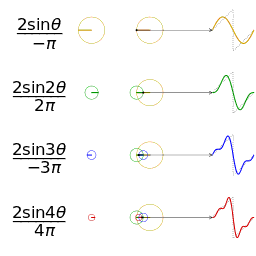
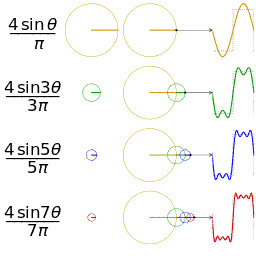

![{\displaystyle {\hat {s}}[n]}](http://wikimedia.org/api/rest_v1/media/math/render/svg/4759449679108f08a78be5a080c3db89dc27ffea)
![{\displaystyle S[n]}](http://wikimedia.org/api/rest_v1/media/math/render/svg/0b4222b53917b43f530116997b71049100c95586)

![{\displaystyle s(x)=\sum _{n=-\infty }^{\infty }S[n]\cdot e^{i\,2\pi nx/P}\quad }](http://wikimedia.org/api/rest_v1/media/math/render/svg/92f87178156b61cc57fc94240bec5985c4ce63d2)
![{\displaystyle S(f)\ \triangleq \ \sum _{n=-\infty }^{\infty }S[n]\cdot \delta \left(f-{\frac {n}{P}}\right)}](http://wikimedia.org/api/rest_v1/media/math/render/svg/27177d458017a95aa1b728c68060767743e370db)

![{\displaystyle {\begin{aligned}{\mathcal {F}}^{-1}\{S(f)\}&=\int _{-\infty }^{\infty }\left(\sum _{n=-\infty }^{\infty }S[n]\cdot \delta \left(f-{\frac {n}{P}}\right)\right)e^{i2\pi fx}\,df\\&=\sum _{n=-\infty }^{\infty }S[n]\cdot \int _{-\infty }^{\infty }\delta \left(f-{\frac {n}{P}}\right)e^{i2\pi fx}\,df\\&=\sum _{n=-\infty }^{\infty }S[n]\cdot e^{i\,2\pi nx/P}\ \ \triangleq \ s_{\infty }(x)\end{aligned}}}](http://wikimedia.org/api/rest_v1/media/math/render/svg/c5ffcbcac13a0f7db7d5dd8c21183bb89b0d3af9)



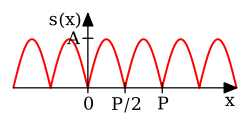


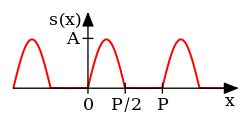






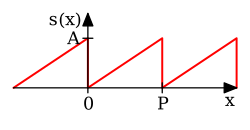


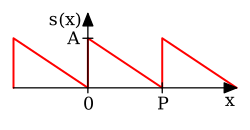






![{\displaystyle x\in [0,P]}](http://wikimedia.org/api/rest_v1/media/math/render/svg/7b67d1c1f507ec8b6185021d3269fc4d4103c57b)
![{\displaystyle R[n]}](http://wikimedia.org/api/rest_v1/media/math/render/svg/bd850b8b42dd52a3e6a55ac7129524e7d4af105b)

 ,
,  ...
...

![{\displaystyle S[-n]}](http://wikimedia.org/api/rest_v1/media/math/render/svg/ab628b28c49c04cab81d0bd30d19ee0797b0587c)

![{\displaystyle S^{*}[-n]}](http://wikimedia.org/api/rest_v1/media/math/render/svg/a3f6ea8a947b86f8a31046070359f6b8111a0bae)

![{\displaystyle S^{*}[n]}](http://wikimedia.org/api/rest_v1/media/math/render/svg/3776c67c40997d8044720ef84de7575679cf9638)

![{\displaystyle {\frac {1}{2}}(S[n]+S^{*}[-n])}](http://wikimedia.org/api/rest_v1/media/math/render/svg/2eb44dffaae6c85870914249c054e33236b02cc8)

![{\displaystyle {\frac {1}{2i}}(S[n]-S^{*}[-n])}](http://wikimedia.org/api/rest_v1/media/math/render/svg/bc039a9c12ae20a4b47337ae55bf8a7bc26d2e11)

![{\displaystyle \operatorname {Re} {(S[n])}}](http://wikimedia.org/api/rest_v1/media/math/render/svg/140ebff319eb8eb7965d0ca86dcaadb21685177a)

![{\displaystyle \operatorname {Im} {(S[n])}}](http://wikimedia.org/api/rest_v1/media/math/render/svg/0c726948120015ce0d482f5f7f4af81713342b5c)

![{\displaystyle S[n]\cdot e^{-i{\frac {2\pi }{P}}nx_{0}}}](http://wikimedia.org/api/rest_v1/media/math/render/svg/5d12b77e7a475835941ca9190940a1c6b11ff848)


![{\displaystyle S[n-n_{0}]\!}](http://wikimedia.org/api/rest_v1/media/math/render/svg/07385c0e5fd45d4e07a279a91668cf8894963e0c)












![{\displaystyle {\begin{aligned}A_{n}&={\frac {1}{\pi }}\int _{-\pi }^{\pi }s(x)\cos(nx)\,dx=0,\quad n\geq 0\\[4pt]B_{n}&={\frac {1}{\pi }}\int _{-\pi }^{\pi }s(x)\sin(nx)\,dx\\[4pt]&=-{\frac {2}{\pi n}}\cos(n\pi )+{\frac {2}{\pi ^{2}n^{2}}}\sin(n\pi )\\[4pt]&={\frac {2\,(-1)^{n+1}}{\pi n}},\quad n\geq 1\end{aligned}}}](http://wikimedia.org/api/rest_v1/media/math/render/svg/b6f5c4fb95b6f6bb17b2673b083479b652b42e32)
![{\displaystyle {\begin{aligned}s(x)&=A_{0}+\sum _{n=1}^{\infty }\left(A_{n}\cos \left(nx\right)+B_{n}\sin \left(nx\right)\right)\\[4pt]&={\frac {2}{\pi }}\sum _{n=1}^{\infty }{\frac {(-1)^{n+1}}{n}}\sin(nx),\quad \mathrm {for} \quad x-\pi \notin 2\pi \mathbb {Z} \end{aligned}}}](http://wikimedia.org/api/rest_v1/media/math/render/svg/591d6757bad021d069ecaee42fc178e9830dfbe5)




![{\displaystyle (x,y)\in [0,\pi ]\times [0,\pi ]}](http://wikimedia.org/api/rest_v1/media/math/render/svg/c18734f151b17b5d3e325f79c7000826ab832610)










![{\displaystyle {\frac {1}{2}}[x(t^{-})+x(t^{+})]}](http://wikimedia.org/api/rest_v1/media/math/render/svg/49230b01e93db8171d55b34288c6d4d8097278b3)
![{\displaystyle [0,2\pi ]}](http://wikimedia.org/api/rest_v1/media/math/render/svg/348d40bf3f8b7e1c00c4346440d7e2e4f0cc9b91)























![{\displaystyle H[n]=(S*R)[n]}](http://wikimedia.org/api/rest_v1/media/math/render/svg/74c5a5260d6ac3aac1292a8e4d4a1b4666082a8b)

![{\displaystyle H[n]=P\cdot S[n]\cdot R[n]}](http://wikimedia.org/api/rest_v1/media/math/render/svg/97c557e56479db0c1f29a2b223cb804b6c0487db)


![{\displaystyle L^{1}([0,2\pi ])}](http://wikimedia.org/api/rest_v1/media/math/render/svg/bd16426bda528c05e32e97bfba7f51b598c081b8)













![{\textstyle \lim _{|n|\to \infty }S[n]=0}](http://wikimedia.org/api/rest_v1/media/math/render/svg/7fc04d857f6462ae29422edcada981c8a798d4b5)


![{\displaystyle L^{2}([-\pi ,\pi ])}](http://wikimedia.org/api/rest_v1/media/math/render/svg/0f84fea7a212acaf14649b6cdcca282b0646a8b0)




![{\displaystyle S[n]=c_{n}}](http://wikimedia.org/api/rest_v1/media/math/render/svg/c4375307afdf29e78a31ef64b699dcb3e2fde140)



